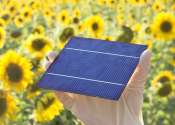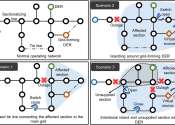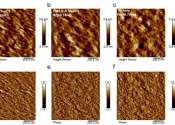'Self-healing' solar cells could become reality
Solar cells of the future could be able to withstand corrosive susceptibility by "self-healing," in a break-through the scientific community has long been pursuing.
Jun 27, 2024
0
47
Electronics & Semiconductors

Solar cells of the future could be able to withstand corrosive susceptibility by "self-healing," in a break-through the scientific community has long been pursuing.
Jun 27, 2024
0
47
Engineering

Energy Harvesting is a green technology that captures (or "harvests") wasted energy and converts it into electricity. The ubiquitous vibrations that surround us are one of the promising sources for energy harvesting. In particular, ...
Jun 25, 2024
0
1
Energy & Green Tech

University of Texas at Dallas researchers have developed an artificial intelligence (AI) model that could help electrical grids prevent power outages by automatically rerouting electricity in milliseconds.
Jun 24, 2024
0
52
Energy & Green Tech

On the weekend, an area 20km off the Illawarra coast south of Sydney became Australia's fourth offshore wind energy zone. It's the most controversial zone to date, with consultation attracting a record 14,211 submissions—of ...
Jun 23, 2024
0
9
Energy & Green Tech

To make organic solar cells (OSC) competitive, the light-absorbing molecules should simultaneously satisfy multiple key requirements, including a weak-absorption charge transfer state, a high dielectric constant, suitable ...
Jun 21, 2024
0
50
Energy & Green Tech

Peter Dutton has announced that under a Coalition government, seven nuclear power stations would be built around the country over the next 15 years.
Jun 21, 2024
1
1
Energy & Green Tech

Green hydrogen often, but certainly not always, leads to CO2 gains. This claim is based on research published in Nature Energy by Kiane de Kleijne from Radboud University and Eindhoven University of Technology.
Jun 21, 2024
0
23
Energy & Green Tech

When you graph electricity demand in power grids with lots of solar panels, it looks a bit like a duck, with high points in the morning and evening (when people are relying on the grid) and a big dip in the middle of the ...
Jun 18, 2024
0
48
Energy & Green Tech

The pressure is on for California to meet its clean-vehicle goals. In less than two years, 35% of vehicles sold must have zero tailpipe emissions. And by 2035, all light-duty vehicles sold must be zero-emissions.
Jun 14, 2024
0
30
Energy & Green Tech

A research team in Korea Institute of Energy Research has successfully demonstrated the effectiveness of a green hydrogen system used to supplement the volatility of renewable energy. Green hydrogen is hydrogen obtained by ...
Jun 12, 2024
0
28
Solar power is the result of converting sunlight into electricity. Sunlight can be converted directly into electricity using photovoltaics (PV), or indirectly with concentrating solar power (CSP), which normally focuses the sun's energy to boil water which is then used to provide power. The largest solar power plants, like the 354 MW SEGS, are concentrating solar thermal plants, but recently multi-megawatt photovoltaic plants have been built. Completed in 2008, the 46 MW Moura photovoltaic power station in Portugal and the 40 MW Waldpolenz Solar Park in Germany are characteristic of the trend toward larger photovoltaic power stations. Much larger ones are proposed, such as the 550 MW Topaz Solar Farm, and the 600 MW Rancho Cielo Solar Farm.
Solar power is a predictably intermittent energy source, meaning that whilst solar power is not available at all times, we can predict with a very good degree of accuracy when it will and will not be available. Some technologies, such as solar thermal concentrators with an element of thermal storage, have the potential to eliminate the intermittency of solar power, by storing spare solar power in the form of heat; and using this heat overnight or during periods that solar power is not available to produce electricity. This technology has the potential to make solar power "dispatchable", as the heat source can be used to generate electricity at will. Solar power installations are normally supplemented by storage or another energy source, for example with wind power and hydropower.
This text uses material from Wikipedia, licensed under CC BY-SA